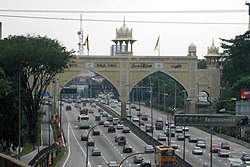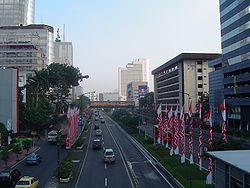While the design of the motorcycle lanes on some federal roads in Malaysia can be considered as acceptable, the design of motorcycle lanes on expressways is often criticized by Malaysian motorcyclists due to several issues.
Design and maintenance
The chief reason that had contributed to the design-related criticisms of the segregated motorcycle lanes on expressways is the adoption of the design standards of segregated bicycle lanes, namely the standards defined by Arahan Teknik (Jalan) 10/86: A Guide to the Design of Cycle Track by Malaysian Public Works Department. [3] According to Arahan Teknik (Jalan) 10/86: A Guide to the Design of Cycle Track, the typical design speed limit being applied on cycle tracks is as low as 60 km/h. [4] However, the design speed limit is too low, as the reported 85th percentile operating speeds of motorcyclists along the motorcycle lanes at the Federal Highway during peak hours and non-peak hours are 72 km/h and 80 km/h respectively. [5]
Due to the operating speeds almost the same as the speed limit of the main carriageways itself, T. H. Law et al. (2005) suggest that the minimum width of the segregated motorcycle lane at the Federal Highway should be set at 3.81 m. However, the average width the existing segregated motorcycle lanes, such as that which is located on the Federal Highway, is only two meters wide. The width of the motorcycle lane is too narrow for bigger motorcycles, as well as for the purpose of overtaking. [5]
According to G. Ramasamy, one of the engineers being responsible for the construction of the Federal Highway between 1974 and 1977, he explained that the constructors built a pair of cycle tracks along the highway to segregate the bicycle traffic from the main carriageways. However, he was shocked to find out that the bicycle lanes had ultimately been turned to motorcycle lanes, as those lanes were not designed to accommodate motorcycle traffic. [6]
Motorcyclists exit the motorcycle lane when approaching an interchange via small off-ramps. Sometimes the off-ramps are too narrow for the motorcyclists, especially for bigger motorcycles. Some ramps require motorcyclists to stop and look for the oncoming cars before it is safe to exit the lane. Hence, motorcyclists exiting motorcycle lanes may present the risk of collision from behind.
Every time that a motorcycle lane approaches an interchange, the motorcycle lane passes sharp corners as well as some tunnels. The corners are dangerous for motorcyclists if they are riding at speeds above 35 km/h.
Besides risking the safety of the motorcyclists, the sharp corners near an interchange also significantly increase the traveling distance for motorcyclists. The best example is the Seputeh interchange at the Federal Highway, where motorcyclists from Klang direction who wish to turn to Salak Expressway have to pass two roundabouts, several winding lanes and several tunnels.
Some stretches of the motorcycle lanes are flooded, although the PLUS concessionaire has placed pumps in a tunnel to address the issue. [7] Some stretches may have potholes and also covered with sand which often causes troubles for motorcyclists. [7] The lanes are also poorly illuminated and less monitored.
Response from the government
On 24 April 2013, a video of the poor conditions of the Federal Highway was uploaded to Facebook and went viral throughout blogs and other Facebook pages, including the Ministry of Work's own Facebook page. The uploader, Muhamad Azree from Shah Alam, also reported the matter to the Ministry of Works himself. [8] Due to the virality of the video throughout the Malaysian cyberspace, the newly appointed Minister of Works, Datuk Fadillah Yusof, announced that his ministry will set up a team to resolve the safety issues of the segregated motorcycle lanes along the Federal Highway. [9] In addition, the Chairman of the National Institute of Occupational Safety and Health (Niosh), Tan Sri Lee Lam Thye, urged the agencies under the Ministry of Works to improve the condition of the motorcycle lanes to become safer and more comfortable, in order to encourage motorcyclists to use them. [10]

